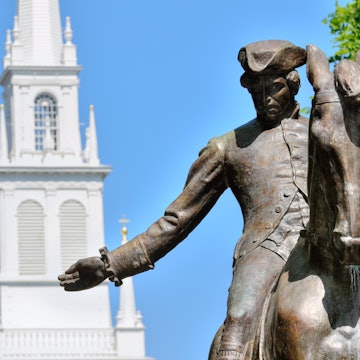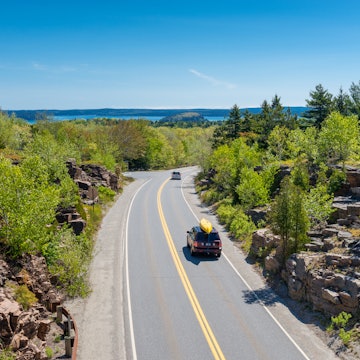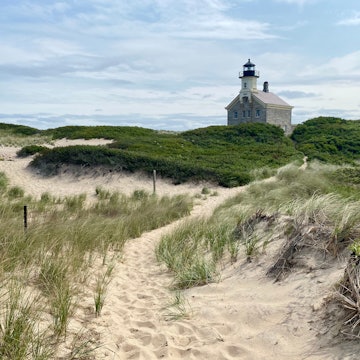
The 15 best places to explore New England’s history

Feb 12, 2025 • 10 min read

The Evergreens at the Emily Dickinson Museum in Amherst, Massachusetts. Sandra Foyt/Shutterstock
When the British Pilgrims landed in Plymouth back in 1620, they started something big. In the four centuries since, New England has been at the forefront of American history, including as the birthplace of the American Revolution. It has been inspiring great poets and thinkers, embracing technological innovation, and spurring on social change ever since.
So many momentous events have occurred in New England that it’s difficult to imagine what America today would look like – or if it would even exist – without these six states. While New England’s foundational story begins around 1620, this is a nuanced history.
You can explore some of the region's diverse narratives through these 15 historic sites.

1. Plimoth Patuxet
Plymouth, Massachusetts
In 1620, the Mayflower made landfall. It was the first of four ships bearing groups of religious dissidents from England who would create a new life for themselves in this unknown land across the Atlantic. The Plimoth Patuxet museums have re-created this 1627 English village with exacting authenticity. Everything in the village – costumes, implements, vocabulary, artistry, recipes and crops – has been painstakingly researched and remade. Historical interpreters, in costume and in character, explain the details of daily life and answer your questions as they work and play. And yes, you will be invited to participate! A highlight is the Craft Center, where you can help artisans as they weave baskets, throw pottery and build furniture using the techniques and tools of the early 17th century.
Planning tip: Ticket options are available based on the museum’s multiple living history sites: Historic Patuxet Homesite, Craft Center, 17th-century English village, Mayflower II and Plimoth Grist Mill. Get more information on the website.
2. Jethro Coffin House
Nantucket, Massachusetts
The Jethro Coffin House, Nantucket’s oldest home on its original foundation, was built in 1686 – almost a century before the United States was born. Occupied by the pioneering Coffin family back when the native Wampanoags outnumbered British settlers three-to-one, this traditional Cape Cod saltbox was gifted to Jethro, a second-generation settler, and his wife, Mary, as a wedding present – a marriage uniting two previously feuding families.
Sitting atop Sunset Hill, its rooms remain stuck in time, amidst an enchanting garden setting where tended herbs and vegetables grow outside the kitchen window – just like in the days of yore.
Planning tip: Open for tours from June to October; free admission.
3. The Old State House
Boston, Massachusetts
Boston’s Old State House is a surprising vestige of 18th-century America amid the bustle of modern life. Before the revolution, the seat of the Massachusetts government was the 9 Old State House, a striking redbrick colonial edifice. Inside, you can peruse historic artifacts and listen to firsthand accounts of revolutionary events. Outside, gaze up at the balcony, where the Declaration of Independence was first read to Bostonians in 1776.
Planning tip: Visitors can purchase a joint ticket to visit the Old State House and Old South Meeting House from Revolutionary Spaces.

4. Buckman Tavern
Lexington, Massachusetts
At the Buckman Tavern, the well-worn floorboards, blackened fireplace and low beamed ceiling look just as they did back on April 19, 1775. In the wee hours of that spring morning, militiamen gathered in the taproom awaiting word for the call to action. At 4:30am, a rider made the announcement: British troops were heading their way to weed out the resistance. Captain John Parker summoned his men, and they poured out of the tavern and onto Lexington Common. By 5am the first shots had been fired, and the American Revolution was underway.
Today, visitors will find galleries upstairs featuring rotating exhibitions. Audio tours are included with the price of admission.
Planning tip: A joint ticket for Buckman Tavern, Hancock-Clarke House and Munroe Tavern from the Lexington Historical Society.
5. The 1840s Boarding Houses
Lowell, Massachusetts
The planned town of Lowell was built in the 1820s along the Merrimack, a mighty river that seemed ideal for powering a water-driven textile mill. Soon after its completion, job seekers poured in, and by 1840 there were over 8000 workers. Some 75% of them were women, drawn from farming backgrounds to work in a burgeoning new industry. Known as “mill girls,” these laborers – some as young as 10 – lived in boarding houses in groups of 20 to 40, with four to six girls per room. The boarding houses persisted into the 20th century, though by the 1900s male boarders outnumbered females, who were largely replaced by a new workforce of immigrants.
Planning tip: To get a sense of what it might have been like to live in a boarding house, visitors can experience a self-guided tour housed in the Patrick J. Mogan Cultural Center.

6. Billings Farm and Museum
Woodstock, Vermont
One mile north of Woodstock’s village green, Vermont’s agricultural history comes to life at Billings Farm & Museum, a historic farmstead founded by 19th-century railroad-magnate Frederick Billings. Next to the ticket office, you can watch the half-hour documentary A Place in the Land, or tour Billings Farm’s excellent museum, jam-packed with vintage machinery for haying, threshing, maple sugar-making and other traditional farm activities.
7. Emily Dickinson Museum
Amherst, Massachusetts
Emily Dickinson (1830–86) is now recognized as one of the most creative and prolific poets in American literary history, but her poetry was unconventional for its time, and she published only seven pieces in her lifetime.
Dickinson spent almost her entire life in Amherst, where she was born and died in the yellow brick house known as the Homestead. It’s one of two side-by-side family houses that make up the Emily Dickinson Museum, which is open for guided tours from March to December. The fascinating tours delve into the poet’s life and works, dispelling many myths about her reclusive lifestyle.
Planning tip: Advance reservations are recommended (emilydickinsonmuseum.org).

8. Dune Shacks
Provincetown, Massachusetts
Hidden among the sandy hills of northern Cape Cod, the small rustic cabins known as Dune Shacks look as though they’ve blown in from a ghost town of the Southwest. In fact, their roots stretch back to 1872, when the first life-saving hut was built to serve the maritime industry. Their purpose evolved over the years, as huts were turned into primitive dwellings and later used by artists as summertime studios.
Though now owned by the National Park Service, some artists still have leases to use the properties. Seven of the dune shacks also host artist-in-residence lotteries and educational programs.
9. African Burying Ground
Portsmouth, New Hampshire
In 2003, construction workers in downtown Portsmouth uncovered 13 coffins buried beneath the street. DNA tests confirmed that they were the remains of African men, women and children, while researchers soon determined that the site was a former burying ground from 1705. It was a momentous discovery, proving what for years had been passed on through oral histories.
Today, the beautifully commemorated site memorializes both free and enslaved people who contributed to the economic and cultural fabric of the city. It’s also one of many significant stops on the Black Heritage Trail that delves into an often overlooked part of New England history.

10. Campobello Island, Canada
Lubec, Maine
If you’ve made it all the way to Lubec, you might as well cross the bridge over the Lubec Narrows and have a peek at an island on the Canadian side. Campobello Island was a favorite getaway for President Franklin Delano Roosevelt, first lady Eleanor Roosevelt and their family. Their well-preserved home is open to visitors from late May to early October, while the surrounding trail-filled park is open year-round, offering fine coastal views and picnic areas.
Start off at the Edmund S Muskie Visitor Centre, which has exhibitions on FDR and a short film about several generations of Roosevelts. You can also get information about tours, hiking trails and other local sites on the island. Next, head to the 34-room Roosevelt Cottage, where Franklin and Eleanor spent many fine summers. Free guided tours depart every 45 minutes or so, and provide a fascinating insight into the Roosevelts’ days on this serene island.
Planning tip: You’ll need a car to get here, as well as a passport – a border post anchors both ends of the Franklin Delano Roosevelt Bridge (which lies at the eastern end of ME 189).
11. MIT Museum
Cambridge, Massachusetts
The MIT Museum, a part of Massachusetts Institute of Technology, is a fantastic display of the university’s research and innovations. Thought-provoking exhibits focus on genetic technology, artificial intelligence and solar-powered vehicles. Several surprising inclusions explore the interplay between science and art.
In 1940, British scientists shared a top-secret discovery with their American counterparts. The cavity magnetron was the core technology for microwave radar and it would prove pivotal for ending WWII. Managers at MIT got to work, creating the MIT Radiation Lab and assembling nuclear physicists, engineers and technicians to create over 150 different systems for radar and navigation. The device is just one of many surprising objects on display in the MIT Museum’s vast collection.

12. The Front Porch
Ogunquit, Maine
Ogunquit had been a destination for the LGBTIQ+ community since at least 1917 – the year Marsden Hartley and other artists spent their summer by the shore. Life was fairly closeted in this small Maine town, however, for most of the 20th century. All that changed in 1980, when JJ Revere opened the Front Porch. Ever a lover of piano bars in Manhattan, Revere created a fun environment where all were welcome and no one needed to hide their sexual orientation.
There are plenty of reasons to make a stop in Ogunquit for a fun afternoon or evening at the Front Porch. Going strong for over 40 years, the piano bar (just upstairs via the main restaurant entrance) draws fans from far and wide to join the off-key sing-alongs around the shiny white grand piano. Expect Broadway show tunes, pop hits and classics by Billy Joel and, of course, Elton John. Piano players are also very much open to taking requests.
Planning tip: The schedule varies throughout the year, with live players on hand daily in the summer months and weekends only off-season. Go early to beat the crowds.
13. Boston Marathon Memorial
Boston, Massachusetts
In 2019, an elegant sculpture was unveiled in Back Bay. Local artist Pablo Eduardo had created four glass and bronze pillars that light up at night to remember the victims of Boston’s worst terrorist attack. Beside them, newly planted cherry trees bloom in April, the month when the marathon takes place. The city also declared April 15 “One Boston Day” to honor the victims of the bombing, and to encourage citizens to volunteer or engage in small acts of kindness for the betterment of the community.

14. Hildene
Manchester, Vermont
Crowning a hilltop two miles south of Manchester, Hildene is the imposing 24-room Georgian Revival mansion of Robert Todd Lincoln, son of Abraham and Mary Lincoln. Surrounding the house is a sprawling 412-acre estate with expansive views of the Battenkill Valley and the Taconic and Green Mountains. Lincoln family members lived here until 1975, when Hildene was converted into a museum. The house is packed to the rafters with the Lincolns’ original furnishings, personal effects and family photos. Highlights include a magnificent Aeolian organ dating back to 1908 and presidential memorabilia, including one of Lincoln’s famous top hats. Directly adjoining the mansion is the exquisite Hoyt Formal Garden, with hedges and flowers arrayed to resemble a stained glass window. The gardens are especially stunning in June, when the peonies are in full bloom. North of the mansion, a short walking loop leads to the Cutting and Kitchen Garden , a plushly furnished classic Pullman train car dating to 1903 and the solar-powered goat dairy.
Back at the Hildene welcome center you’ll find a gift shop whose offerings include local cheese, along with a cafe.
Planning tip: Visitors can take a self-guided tour of the mansion any time of year; guided tours are also offered from June to mid-September, or by reservation at other times of year (subject to guide availability).
15. Hopkins Center for the Arts
Hanover, New Hampshire
Dartmouth College has always been at the vanguard when it comes to the arts. In the 1930s, the great Mexican painter José Clemente Orozco created murals, then controversial, that became one of the college’s great treasures and a national historic landmark. Nearly a century later, Dartmouth continues to break new ground – quite literally – with the expansion of the Hopkins Center for the Arts, providing new spaces to display the work of innovative performers and artists across disciplines.















